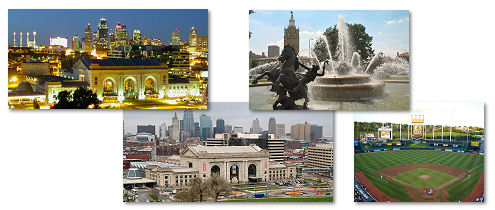
City Maps/Weather
| Fun City Facts The Rockville Bridge, the longest stone arch bridge in the world, is in Harrisburg, Pennsylvania. The Space Needle, built in 1961 in Seattle, Washington is the first revolving restaurant. |
|
|
||||||||
Kansas City, Missouri
City History |
||||||||
 The first documented European visit to Kansas City was Étienne de Veniard, Sieur de Bourgmont, who was also the first European to explore the lower Missouri River. Criticized for his handling of a Native American attack of Fort Detroit, he had deserted his post as commander of the fort and was avoiding the French authorities. Bourgmont lived with a Native American wife in the Missouri village about 90 miles east near Brunswick, Missouri, and illegally traded furs. The Spanish took over the region in the Treaty of Paris in 1763 but were not to play a major role in the area other than taxing and licensing all traffic on the Missouri River. The French continued their fur trade on the river under Spanish license. After the Louisiana Purchase, Lewis and Clark visited the confluence of the Kansas and Missouri rivers, noting it was a good place to build a fort. In 1833 John McCoy established West Port along the Santa Fe Trail then in 1834, McCoy established Westport Landing to serve as a landing point for West Port. Soon after, the Kansas Town Company, a group of investors, began to settle the area. In 1850 the landing area was incorporated as the Town of Kansas. The area was ripe with animosity as the Civil War approached. As citizens of a slave state, Missourians tended to sympathize with the southern states. With Kansas petitioning to enter the Union under the new doctrine of popular sovereignty, many from the area crossed into Kansas to sway the state towards allowing slavery, at first by ballot box and then by bloodshed. During the Civil War, the City of Kansas was in the midst of battles, almost all of them victories by the Union. The Battle of Independence in August 1862 and the October 1864 Battle of Westport effectively ended Confederate efforts to occupy the city. After the Civil War, the City of Kansas grew rapidly however, the population really exploded after 1869 when the Hannibal Bridge opened. The boom prompted a name change to Kansas City in 1889 and the city limits to extend south and east. The city guided by architect George Kessler, became a forefront example of the City Beautiful movement, developing a network of boulevards and parks around the city. After World War II, the city experienced considerable sprawl, as the wealthy populace left for suburbs, however, many also went north of the Missouri River, where Kansas City had incorporated areas between the 1940s to 1970s. The population of the urban core significantly dipped, while the city as a whole gained population. The future for sprawl in Kansas City is uncertain, however, recent revelations in urban planning have slowed sprawl and focused instead on the inner city, existing infrastructure and housing, as well as reviving the city's formerly blighted downtown. Kansas City has more fountains than any other city in the world with the exception of Rome. Today the city's tap water was recently rated the cleanest among the 50 largest cities in the United States, containing no detectable impurities. The city also has more boulevards than any city except Paris and has often been called a "Paris on the Plains." |
Historic Figures
Thomas Joseph Pendergast (1873 –1945)| Thomas Joseph Pendergast (1873 –1945) | |
| "Boss Tom" Pendergast controlled Kansas City and Jackson County, Missouri as a political boss. He gave workers jobs and helped elect politicians during the Great Depression, becoming wealthy in the process. His older brother, a member of Kansas City, Missouri's city council, taught him about the city's political system and the advantages of controlling blocks of voters. Jim retired in 1910 and died the next year, naming Tom his successor. Pendergast served in the city council until stepping down in 1916 to focus on consolidating the faction of the Jackson County Democratic Party. After a new city charter passed in 1925 placed the city under the support of a city manager picked by a smaller council, Pendergast easily gained control of the government. | |
browse cities | search | get listed | spotlight | about us | contact us | policies | partners
Copyright ©2024 www.ByCityLight.com - Page Design by Erik Schubach and Tristan Chambers